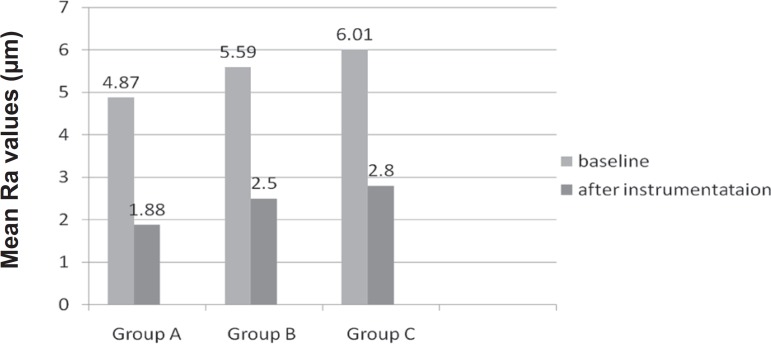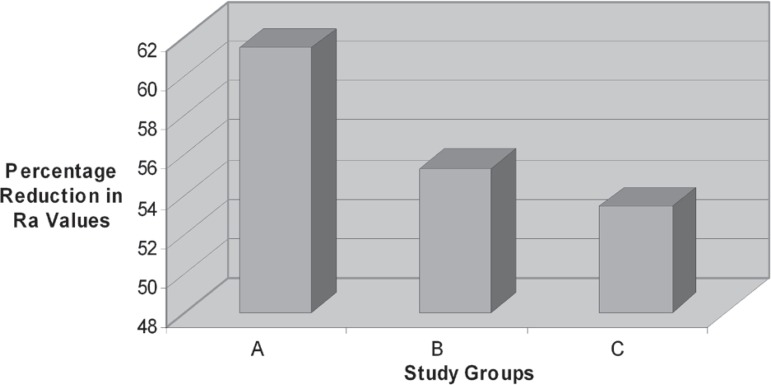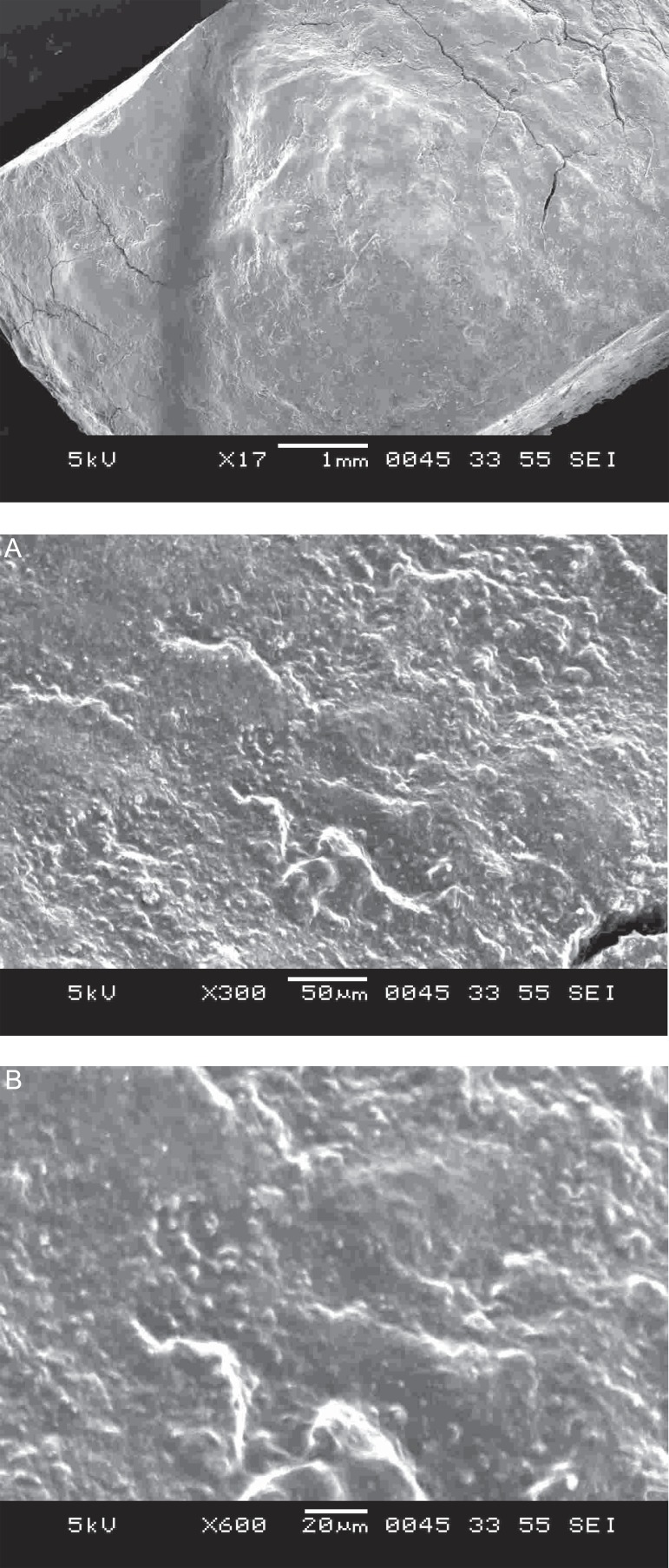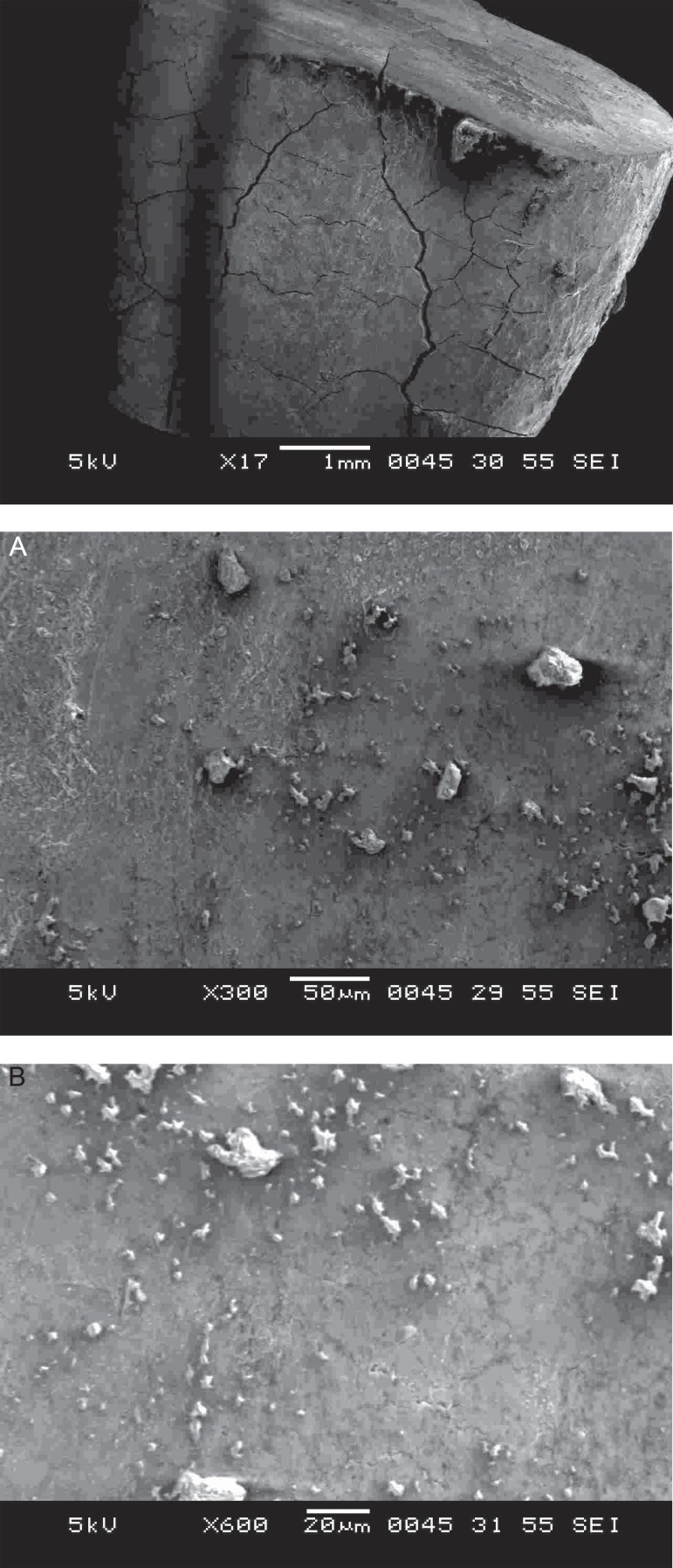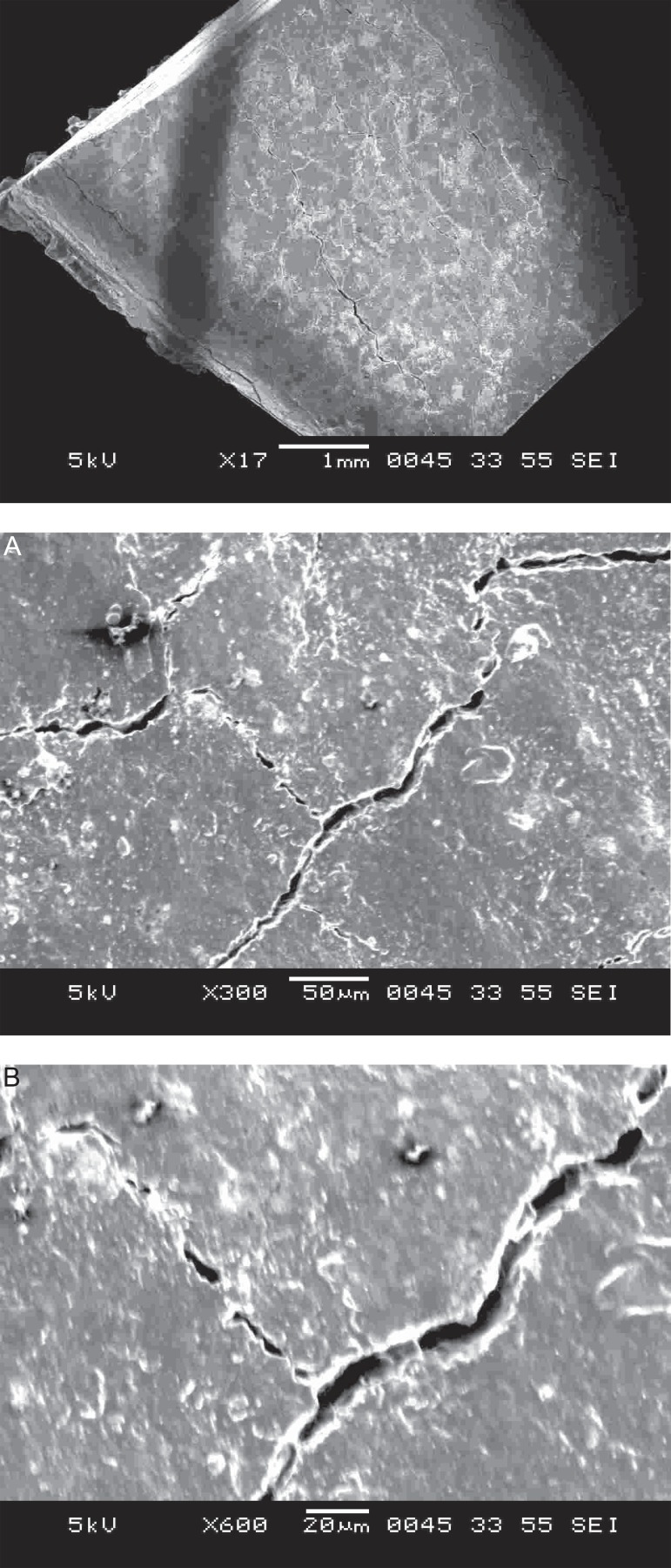Abstract
Objectives
The debridement of diseased root surface is usually performed by mechanical scaling and root planing using manual and power driven instruments. Many new designs in ultrasonic powered scaling tips have been developed. However, their effectiveness as compared to manual curettes has always been debatable. Thus, the objective of this in vitro study was to comparatively evaluate the efficacy of manual, magnetostrictive and piezoelectric ultrasonic instrumentation on periodontally involved extracted teeth using profilometer and scanning electron microscope (SEM).
Material and Methods
30 periodontally involved extracted human teeth were divided into 3 groups. The teeth were instrumented with hand and ultrasonic instruments resembling clinical application. In Group A all teeth were scaled with a new universal hand curette (Hu Friedy Gracey After Five Vision curette; Hu Friedy, Chicago, USA). In Group B CavitronTM FSI - SLITM ultrasonic device with focused spray slimline inserts (Dentsply International Inc., York, PA, USA) were used. In Group C teeth were scaled with an EMS piezoelectric ultrasonic device with prototype modified PS inserts. The surfaces were analyzed by a Precision profilometer to measure the surface roughness (Ra value in µm) consecutively before and after the instrumentation. The samples were examined under SEM at magnifications ranging from 17x to 300x and 600x.
Results
The mean Ra values (µm) before and after instrumentation in all the three groups A, B and C were tabulated. After statistically analyzing the data, no significant difference was observed in the three experimental groups. Though there was a decrease in the percentage reduction of Ra values consecutively from group A to C.
Conclusion
Within the limits of the present study, given that the manual, magnetostrictive and piezoelectric ultrasonic instruments produce the same surface roughness, it can be concluded that their efficacy for creating a biologically compatible surface of periodontally diseased teeth is similar.
Keywords: Magnetostrictive ultrasonic scaling instrument, Piezoelectric ultrasonic scaling instrument, Hand curette, Profilometer, Scanning electron microscopy
INTRODUCTION
One of the objectives of periodontal therapy is the reduction of bacterial deposits and calculus on tooth surface1. This objective can be achieved with hand scalers and curettes or ultrasonic scaling instruments8. Recent clinical studies do not indicate a difference between ultrasonic/sonic and manual debridement in the treatment of chronic periodontitis20. Complete removal of subgingival calculus with hand or ultrasonic instruments is impossible or rare even when a surgical approach is used3,19.
The efficacy of root planing procedures can be studied in two different ways. The tissue healing around the treated teeth can be evaluated, or the teeth may be extracted immediately after treatment in order to observe directly the cleanliness and surface characteristics of the root planed surfaces. A number of authors have used the stereomicroscope to evaluate the residual calculus after extraction of the root planed teeth19. However, precise study of the root planed surface can be performed only by means of scanning electron microscope (SEM)16.
Initially, ultrasonic scalers were employed with apprehension because of suspected root surface damage. This concern was subsequently put to rest by studies such as that of Ritz, et al.18 (1991) where the ultrasonic scaler removed the least root surface substance. The majority of studies investigated only magnetostrictive ultrasonic scalers6,7,18. Little has been published about the piezoelectric ultrasonic instruments. Thus, the present study was conducted to comparatively evaluate the efficacy of manual, magnetostrictive and piezoelectric ultrasonic instruments.
MATERIAL AND METHODS
Thirty periodontally compromised extracted human teeth with supragingival and subgingival calculus were divided into 3 experimental groups using a randomized rank selection programme. Each tooth was positioned horizontally on a dental stone block of 1 "by 1". The teeth were to be instrumented with hand and ultrasonic instruments resembling clinical application. In Group A all teeth were carefully scaled with a new universal hand curette (Hu Friedy Gracey After Five Vision curette; Hu Friedy, Chicago, USA) In Group B CavitronTM FSI - SLITM ultrasonic device with focused spray slimline inserts (Dentsply International Inc., York, PA, USA) were used. In Group C teeth were scaled with an EMS piezoelectric ultrasonic device with prototype modified PS inserts.
With the hand curette the working strokes ran from apical to coronal direction, parallel to the long axis of the tooth. The curette was re-sharpened with a sharpening stone (Art. 303356, Arkansas stone No. 6A, Hu-Friedy, Leimen, Germany) after instrumenting each tooth. The insert tips were parallel to the tooth axis and the working strokes ran perpendicular to the tooth axis. The application method for both ultrasonic devices was same. Clinically appropriate force of application was ensured as only one operator duly trained in the set procedure carried out debridement of all teeth. Each tooth was instrumented till the root surface was visually and tactilely clean and smooth as confirmed by a sharp Cow Horn Explorer (Hu-Friedy).
The surfaces were analyzed by a Precision profilometer (Form Surtronic 3+, Rank Taylor Hobson, Leicester, UK) to measure the surface roughness (Ra value in µm) consecutively before and after the instrumentation. The reading was recorded three times. Special care was taken to make the post experimental tracings in the same positions as at baseline.
The samples were examined under scanning electron microscopy (SEM) (JEOM JSM- 6380 LA, Analytical SEM) at magnifications ranging from 17x to 300x. Additional micrographs at 600x were taken for detailed examination. The surfaces were examined for damage, scratches, gouges, cracks and any remnants of debris.
Statistical analysis
The baseline and end point Ra values as analyzed by the profilometer were compared in the intergroup using ANOVA while intragroup comparison was done using Tukey's test. Also, percentage reduction of Ra value was done by ANOVA and Fischer's test. The significance level was set at 5% for all analyses.
RESULTS
The samples were periodontally involved teeth with hopeless prognosis indicated for extraction. All teeth had supragingival and subgingival calculus and were instrumented until no visible calculus could be assessed by the naked eye and felt by the explorer.
The mean Ra values (µm) before and after instrumentation in groups A, B and C are presented in the form of a bar diagram (Figure 1). After statistically analyzing the data, no significant difference was observed in the three experimental groups.
Figure 1.
Mean Ra values (in μm) before and after instrumentation in all three groups
The percent reduction of Ra value was calculated by:
Though there was a decrease in the percentage reduction of Ra values consecutively from group A to C (Figure 2), it was not statistically significant. In other words, although the piezoelectric ultrasonic (Group C) device with prototype inserts produced root surfaces as clean as with the curette or magnetostrictive ultrasonic device, the overall surface roughness was greater after the piezoelectric instrumentation than the other two instruments.
Figure 2.
Percentage reduction of surface roughness (Ra) values in group A, B and C
SEM analysis
The images acquired from the SEM were used for descriptive analysis. The entire tooth sample as observed in all 3 groups showed cracks on the surface caused by dehydration procedures (Figures 3-5).
Figure 3.
Scanning electron microscopy (SEM) view of group A sample. A: SEM view of group A sample at 300x magnification; B: SEM view of group A sample at 600x magnification
Figure 5.
Scanning electron microscopy (SEM) view of group C sample. A: SEM view of group C sample at 300x magnification; B: SEM view of group C sample at 600x magnification
The SEM observation revealed that all the instruments managed to remove the calculus deposits quite effectively. Large remaining deposits were rarely seen. Remnants of calculus were seen at magnification 300x (Figures 3a, 4a, 5a) and at 600x (Figures 3b, 4b, 5b). Presence of smear layer was noted in all the three groups at high magnifications.
Figure 4.
Scanning electron microscopy (SEM) view of group B sample. A: SEM view of group B sample at 300x magnification. B: SEM view of group B sample at 600x magnification
DISCUSSION
Studies investigating the differences between manual, piezoelectric and magnetostrictive ultrasonic systems are inconclusive8,9. The same has been corroborated by Lea and Walmsley's exhaustive review of literature specifically with respect to powered instruments. It is worthwhile recapitulating that a large number of variables - vibration generation method, water flow rate, tip cross section and generator power, contact load, angle and duration, generator power, tip shape, instrumentation end point, vibration generation method, tip variability, water flow rate, tip cross-section and tip motion - associated with attempts to investigate such differences, make it practically impossible to reach a definite conclusion regarding the method of instrumentation that causes the least amount of root surface alteration13. Using both, stereomicroscope and SEM evaluation, Breininger, et al.2 (1987) compared curettes and ultrasonic methods in removing plaque. They concluded that neither instrument removed all stained accretions. Gouges probably corresponding to the instrument tips were found on all surfaces. Evidently, some form of standardization is required to allow meaningful comparisons to be made between studies.
Further, a number of studies have shown that one session of closed root instrumentation does not achieve the goal of total elimination of all calculus deposits. Other investigations in which flaps have been reflected to secure access and visibility before scaling and root planing have failed to secure calculus free root surfaces. It is worth mentioning at this juncture that even under optimal conditions in vitro it is not always possible to remove entire calculus from all root surfaces. There are generally two methods of evaluating tooth damage in vitro. The first is to apply instrumentation until the tooth surface is clean and clear of calculus as deemed by the operator. The second is to instrument for a controlled length of time or number of strokes. While the latter is often more controlled insofar as operating parameters such as load and contact angle are concerned, clinically it is less appropriate13. Employing the former method in the present study, teeth samples were instrumented until they were clean - clinically a more pertinent aim.
One of the highlights of this study is the fact that periodontally diseased teeth were selected. Results from such a work are more meaningful because that the sample mimics actual conditions in patients unlike works that are carried out on healthy teeth extracted originally for orthodontic reasons6. Moreover, through random allocation of teeth to their respective groups they were well matched as reflected by a lack of any visible differences among initial calculus in each group. This was an important aspect given that these teeth were diseased and affected by calculus.
As aforementioned, mean Ra (µm) values were calculated after instrumentation. The teeth were then examined under a stereomicroscope (magnification 10x); remnants of calculus were seen5. Subsequent SEM analysis showed that surfaces with smaller mean Ra values exhibited less gouges and scratches than those with higher mean Ra values.
SEM observations in our study indicate that the use of hand instruments resulted in a smooth surface than obtained by ultrasonic instruments. Ribeiro, et al.17 (2006) had also concluded that diamond coated sonic tips and ultrasonic universal tips produced similar roughness of surface which was higher than that produced by hand curettes. Our findings corroborate those of some others regarding instrumentation with curettes and ultrasonic instruments12,14,15,21. However, Ewen and Gwinnett10 (1977) did not find any difference while Jones, et al.11 (1972) found slight difference. Such variations in results can be attributed to methods of processing the specimens, magnifications used and techniques of instrumentation. We discovered a difference in the surface finish quality between the two ultrasonic instruments where we felt that the magnetostrictive instrument produced a better surface finish than the piezoelectric device. However, caution should be exercised in interpreting the results too strictly given that a limited number of surfaces were examined and the interpretations were purely subjective.
The difference in Ra values between the two ultrasonic instruments could also be due to a difference in the power output. Thus, while medium power setting was used for both and the same operator conducted the procedure, there was no way of deducing if the two ultrasonic devices delivered similar power at the same settings. The power of the piezoelectric device could have been higher than that of the magnetostrictive device causing more root damage which was interpreted as a higher Ra value4. In a study published in 20066 the authors assessed the manual and ultrasonic root surface scaling at low, medium and high power settings; roughness of the instrumented teeth was evaluated. The authors concluded that ultrasonic instrumentation at high power settings produces rougher root surfaces than ultrasonic instrumentation at lower power; and that manual instrumentation with curettes produces lower roughness than ultrasonic instrumentation independent of power setting.
Notwithstanding these limitations, our results clearly indicate that all three instruments considerably reduced calculus on the root surfaces8. Both ultrasonic and manual instrumentation removed calculus quite effectively as seen by naked eye and SEM at low magnification. Though the ultrasonic methods produced greater disturbance on surface topography than hand instrumentation, given that the differences in surface roughness produced by the three different instruments were not significant, we suggest that ultrasonic scalers are operationally more viable since they ensure more patient comfort and cause less operator fatigue.
CONCLUSION
Within the limits of the present study, given that the manual, magnetostrictive and piezoelectric ultrasonic instruments produce the same surface roughness, it can be concluded that their efficacy for creating a biologically compatible surface of periodontally diseased teeth is similar.
Acknowledgments
ACKNOWLEDGEMENTS
The authors thank the technical staff who ceded the surface roughness measuring instrument (Profilometer) for the execution of this study at the Mechanical Engineering Department, Manipal Institute of Technology, Manipal University, Manipal; and, Department of Metallurgy, National Institute of Technology, Suratkhal, Karnataka for the SEM examination.
REFERENCES
- 1.Axelsson P, Lindhe J, Nyström B. On prevention of caries and periodontal disease. Results of a 15-year longitudinal study in adults. J Clin Periodontol. 1991;18:182–189. doi: 10.1111/j.1600-051x.1991.tb01131.x. [DOI] [PubMed] [Google Scholar]
- 2.Breininger DR, O'Leary TJ, Blumenshine RVH. Comparative effectiveness of ultrasonic and hand scaling for the removal of subgingival plaque and calculus. J Periodontol. 1987;58:9–18. doi: 10.1902/jop.1987.58.1.9. [DOI] [PubMed] [Google Scholar]
- 3.Buchanan SA, Robertson PB. Calculus removal by scaling/ root planing with and without surgical access. J Periodontol. 1987;58:159–163. doi: 10.1902/jop.1987.58.3.159. [DOI] [PubMed] [Google Scholar]
- 4.Busslinger A, Lampe K, Beuchat M, Lehmann B. A comparative in vitro study of a magnetostrictive and a piezoelectric ultrasonic scaling instrument. J Clin Periodontol. 2001;28:642–649. doi: 10.1034/j.1600-051x.2001.028007642.x. [DOI] [PubMed] [Google Scholar]
- 5.Caffesse RG, Sweeney RL, Smith BA. Scaling and root planing with and without periodontal flap surgery. J Clin Periodontol. 1986;13:205–210. doi: 10.1111/j.1600-051x.1986.tb01461.x. [DOI] [PubMed] [Google Scholar]
- 6.Casarin RCV, Pinto FR, Nociti FH, Jr, Sallum EA, Sallum AW, Casati MZ. Assessment of ultrasonic root surface scaling with different power settings: roughness evaluation. Braz J Oral Sci. 2006;5:996–1000. [Google Scholar]
- 7.Dragoo MR. A clinical evaluation of hand and ultrasonic instruments on subgingival debridement. 1. With unmodified and modified ultrasonic inserts. Int J Periodontics Restorative Dent. 1992;12:311–323. [PubMed] [Google Scholar]
- 8.Drisko CH. Root instrumentation. Power-driven versus manual scalers, which one? Dent Clin North Am. 1998;42:229–244. [PubMed] [Google Scholar]
- 9.Drisko CL, Cochran DL, Blieden T, Bouwsma OJ, Cohen RE, Damoulis P, et al. Position paper: sonic and ultrasonic scalers in periodontics. Research, Science and Therapy Committee of the American Academy of Periodontology. J Periodontol. 2000;71:1792–1801. doi: 10.1902/jop.2000.71.11.1792. [DOI] [PubMed] [Google Scholar]
- 10.Ewen SJ, Gwinnett AJ. A scanning electron microscopic study of teeth following periodontal instrumentation. J Periodontol. 1977;48:92–97. doi: 10.1902/jop.1977.48.2.92. [DOI] [PubMed] [Google Scholar]
- 11.Jones SJ, Lozdan J, Boyde A. Tooth surfaces treated in situ with periodontal instruments. Br Dent J. 1972;132:57–64. doi: 10.1038/sj.bdj.4802798. [DOI] [PubMed] [Google Scholar]
- 12.Jotikasthira NE, Lie T, Leknes KN. Comparative in vitro studies of sonic, ultrasonic and reciprocating scaling instruments. J Clin Periodontol. 1992;19:560–569. doi: 10.1111/j.1600-051x.1992.tb00684.x. [DOI] [PubMed] [Google Scholar]
- 13.Lea SC, Walmsley AD. Mechano-physical and biophysical properties of power-driven scalers: driving the future of powered instrument design and evaluation. Periodontol 2000. 2009;51:63–78. doi: 10.1111/j.1600-0757.2009.00300.x. [DOI] [PubMed] [Google Scholar]
- 14.Lee A, Heasman PA, Kelly PJ. An in vitro comparative study of a reciprocating scaler for root surface debridement. J Dent. 1996;24:81–86. doi: 10.1016/0300-5712(95)00034-8. [DOI] [PubMed] [Google Scholar]
- 15.Meyer K, Lie T. Root surface roughness in response to periodontal instrumentation studied by combined use of microroughness measurements and scanning electron microscopy. J Clin Periodontol. 1977;4:77–84. doi: 10.1111/j.1600-051x.1977.tb01887.x. [DOI] [PubMed] [Google Scholar]
- 16.Rateitschak-Plüss EM, Schwarz JP, Guggenheim R, Düggelin M, Rateitschak KH. Non-surgical periodontal treatment: where are the limits? An SEM study. J Clin Periodontol. 1992;19:240–244. doi: 10.1111/j.1600-051x.1992.tb00460.x. [DOI] [PubMed] [Google Scholar]
- 17.Ribeiro FV, Casarin RCV, Nociti FH, Júnior, Sallum EA, Sallum AW, Casati MZ. A comparative in vitro study of root roughness after instrumentation with ultrasonic and diamond tip sonic scaler. J Appl Oral Sci. 2006;14:124–129. doi: 10.1590/S1678-77572006000200011. [DOI] [PMC free article] [PubMed] [Google Scholar]
- 18.Ritz L, Hefti AF, Rateitschak KH. An in vitro investigation on the loss of root substance in scaling with various instruments. J Clin Periodontol. 1991;18:643–647. doi: 10.1111/j.1600-051x.1991.tb00104.x. [DOI] [PubMed] [Google Scholar]
- 19.Kepic TJ, O'Leary TJU, Kafrawy AH. Total calculus removal: an attainable objective? J Periodontol. 1990;61:16–20. doi: 10.1902/jop.1990.61.1.16. [DOI] [PubMed] [Google Scholar]
- 20.Tunkel J, Heinecke A, Flemmig TF. A systematic review of efficacy of machine-driven and manual subgingival debridement in the treatment of chronic periodontitis. J Clin Periodontol. 2002;29(sp. Issue 3):72–81. doi: 10.1034/j.1600-051x.29.s3.4.x. [DOI] [PubMed] [Google Scholar]
- 21.Wilkinson RF, Maybury JE. Scanning electron microscopy of the root surface following instrumentation. J Clin Periodontol. 1973;44:559–564. doi: 10.1902/jop.1973.44.9.559. [DOI] [PubMed] [Google Scholar]



